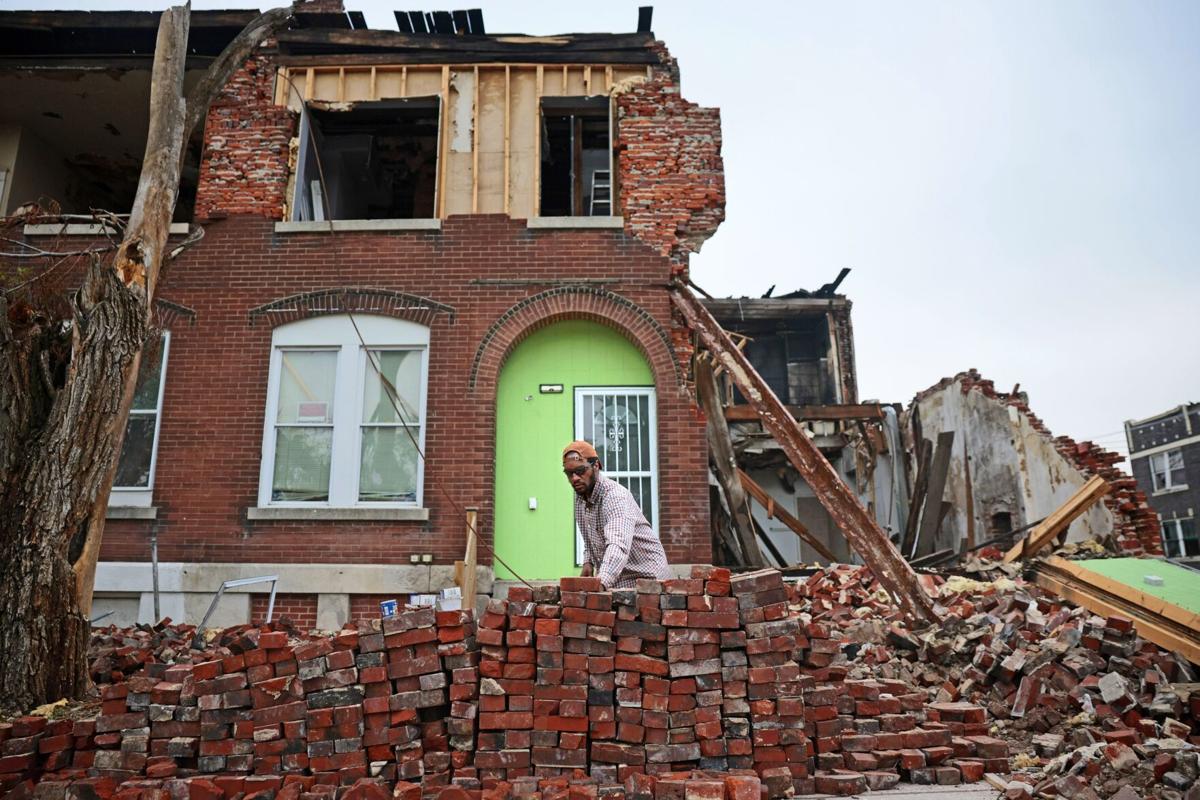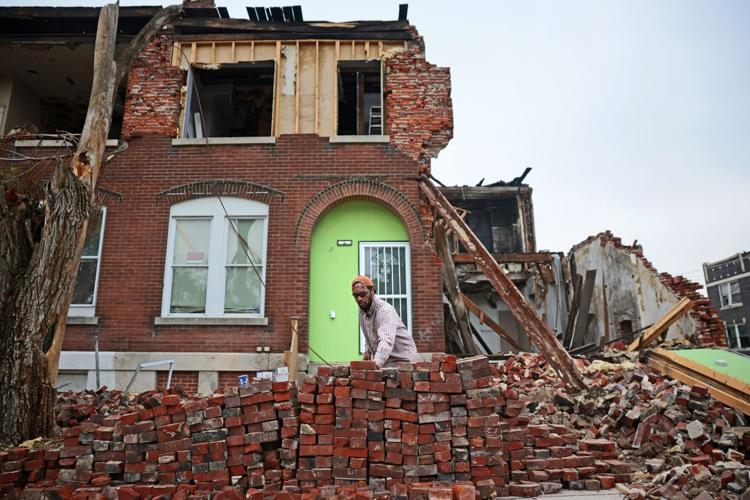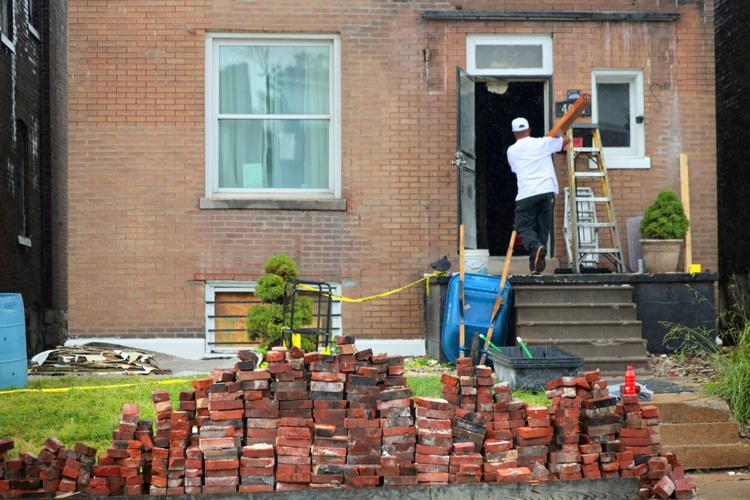ST. LOUIS ŌĆö Beyond immediate needs tied to shelter and safety, preservation experts and local officials say theyŌĆÖve heard a common refrain in the aftermath of last monthŌĆÖs deadly tornado that ravaged parts of 51║┌┴Ž, bringing down multiple brick structures:
kAm(92EŌĆÖD 8@:?8 E@ 364@>6 @7 2== E92E 3C:4< 7C@> 52>2865 3F:=5:?8D ŌĆö 2?5 9@H 42? E96 4:EJ D2G6 E96 >2E6C:2= E92EŌĆÖD 2 5:DE:?4E DJ>3@= @7 $E] {@F:D AC:56 2?5 :56?E:EJ 7C@> =2?57:==D 2?5 A@E6?E:2= =2C46?Jnk^Am
kAmŌĆ£(6ŌĆÖC6 @?6 @7 E96 76H ECF=J 3C:4< 4:E:6D :? E96 4@F?ECJ[ŌĆØ D2:5 p=56C>2? |:4926= qC@H?:?8 @7 E96 hE9 (2C5] ŌĆ£xE DA62<D E@ E96 492C24E6C @7 E96 4:EJ] %92EŌĆÖD 2 492C24E6C H6 H2?E E@ AC6D6CG6]ŌĆØk^Am
kAm~? |2J `e 2? tub E@C?25@ 4FE 24C@DD E96 4:EJ 7C@> E96 r6?EC2= (6DE t?5 2?5 :?E@ ?@CE9 $E] {@F:D ?6:893@C9@@5D @7 9:DE@C:4 C65 3C:4< 9@>6D[ =:<6 u@F?E2:? !2C<[ <:==:?8 7:G6 A6@A=6] w@>6D 2?5 3F:=5:?8D H6C6 E@AA=65 3J E96 DE@C>[ =62G:?8 C@@>D H:E9@FE H2==D @C C@@7D[ 2?5 4C62E:?8 >@F?E2:?D @7 3C:4<[ =F>36C 2?5 >@C6]k^Am
kAm$E] {@F:DŌĆÖ DEC@?8 3C:4< 96C:E286 DEC6E496D 324< H6== @G6C 2 46?EFCJ ŌĆö @C 6G6? E@ A2DE >:==6??:2[ :? 2 86@=@8:42= D6?D6] %96 =@42= 23F?52?46 @7 4=2J AC@G:565 E96 >2E6C:2= E92E :?5FDEC:2=:DED =:<6 E96 wJ5C2F=:4 !C6DD qC:4< r@] 4@?G6CE65 :?E@ F?E@=5 G@=F>6D @7 3C:4<[ DE2CE:?8 :? E96 `g__D]k^Am
kAmuC@> :ED $E] {@F:D 9F3[ E96 4@>A2?J 8C6H E@ 364@>6 E96 H@C=5ŌĆÖD 3:886DE 3C:4< AC@5F46C[ 2?5 4C62E65 H92E ŌĆ£42>6 E@ 36 <?@H? 2D E96 A6C764E 3C:4<ŌĆØ H:E9 2 C65 E:?86[ D2:5 (:== "F2>[ 2 r9:428@\32D65 2C49:E64EFC6 6IA6CE H9@ =625D 3C:4<\C6=2E65 E@FCD[ 2?5 H:== G:D:E $E] {@F:D E@ 8:G6 2 E2=< 23@FE 3C:4<D =2E6C E9:D >@?E9]k^Am
kAmŌĆ£(96? J@F E9:?< @7 E9:D A=2E@?:4 :562= @7 2 3C:4<[ J@FŌĆÖC6 A:4EFC:?8 2 3C:4< >256 :? $E] {@F:D 3J E96 wJ5C2F=:4 !C6DD qC:4< r@][ŌĆØ 96 D2:5] ŌĆ£$E] {@F:D H2D E96 C62= 6A:46?E6C @7 3C:4< 72D9:@? :? E96 =2E6 `hE9 46?EFCJ]ŌĆØk^Am
kAmqC:4<D 42? E2<6 @? 5:776C6?E 9F6D 2?5 492C24E6C:DE:4D[ 32D65 @? =@42= 86@=@8J H96C6 E96:C 4=2J :D 92CG6DE65] u@C 6I2>A=6[ 3C:4<D 7C@> r9:428@ 2?5 |:=H2F<66 2C6 5:DE:?4E=J =:89E6C :? 4@=@C E92? E9@D6 >256 96C6]k^Am
kAm%@52J[ E96 8=@CJ 2?5 8C:E @7 $E] {@F:D 3C:4< 92D >256 E96 >2E6C:2= 2 E2C86E E92E 42? 76E49 AC6>:F> AC:46D[ 2?5 :D 4@G6E65 3J D2=G286CD[ 3C:4<J2C5D[ 3C2K6? E9:6G6D 2?5[ 6G6?EF2==J[ 3F:=56CD 6G6? @FE @7 DE2E6]k^Am
kAmŌĆ£!6@A=6 =@G6 E96 =@@< 2? @=5 3C:4< 2?5 E96J H:== A2J 8@@5 >@?6J 7@C :E[ŌĆØ "F2> D2:5] ŌĆ£%96J H2?E E96 =@@< @7 2 3C:4< E92E 92D H62E96C65 7@C `__ J62CD 2D @AA@D65 E@ 2 >@56C? 3C:4< E92E :D >2J36 E@@ A6C764E]ŌĆØk^Am
kAmw6 D2:5 E92E 2C@F?5 r9:428@[ C64=2:>65 $E] {@F:D 3C:4<D 2C6 D6==:?8 7@C S`]d` 6249[ @C Sg__ 7@C 2 A2==6E @7 db_ 3C:4<D] %92EŌĆÖD 2=>@DE a_T >@C6 E92? C64=2:>65 ŌĆ£r9:428@ r@>>@?ŌĆØ 3C:4<D[ H9:49 96 D2:5 8@ 7@C S`]ad 2A:646]k^Am
kAm%92E 2AA62= @7 $E] {@F:D 3C:4< :D C2:D:?8 762CD E92E E96 E@C?25@ 4@F=5 2446=6C2E6 E96 =@?8\6DE23=:D965 EC6?5 @7 $E] {@F:DŌĆÖ D2=G2865 3C:4< =62G:?8 E@H?[ @7E6? 7@C 56DE:?2E:@?D 24C@DD E96 D@FE96C? &]$][ H96C6 :E 42? 4@>>@?=J 36 D=:465 FA 2?5 FD65 2D 4=255:?8]k^Am
kAmŌĆ£*@F 92G6 A6@A=6 H9@ H:== =@D6 E96:C 9@>6D 2?5 H:== E96? =@D6 E96:C 3C:4< E@ D@>6 >F=E:>:==:@?\5@==2C 56G6=@A>6?E :? E96 $@FE9[ŌĆØ D2:5 "F2>]k^Am
kAmx? E96 H66<D D:?46 E96 E@C?25@[ $E] {@F:D C6D:56?ED[ G@=F?E66CD 2?5 H@C<6CD 92G6 368F? D:7E:?8 E9C@F89 ;F>3=65 A:=6D @7 CF33=6 7C@> E96 52>2865 3F:=5:?8D E92E >2J 36 4@?56>?65 2?5 6>AEJ @C 4@==2AD65[ D@>6E:>6D D6EE:?8 2D:56 E:5J DE24<D @7 3C:4<D]k^Am
kAm#6D:56?ED D2:5 E96J 2?5 E96:C ?6:893@CD :?E6?5 E@ C6FD6 E9@D6 :?E24E[ D2=G2865 3C:4<D E@ C63F:=5 2?5 C6A2:C E96:C 9@>6D]k^Am
kAmŌĆ£x 92G6?ŌĆÖE 962C5 2?J@?6 D2J 2?JE9:?8 23@FE D6==:?8 E96:C 3C:4<D[ŌĆØ D2:5 #:492C5 t==:D[ 2 u@F?E2:? !2C< C6D:56?E H9@ H2D 96=A:?8 H:E9 H@C< 2E 2 ?62C3J 9@>6 @? %9FCD52J ?:89E] ŌĆ£%92E 92D ?@E 6G6? 366? 2 5:D4FDD:@?]ŌĆØk^Am
Bricks from the family home of Gale Davis on Labadie Avenue sit neatly in a pile on Wednesday, June 4, 2025, as a family member carries lumber inside for repairs. Davis and her family plan to repair their damaged facade with the bricks theyŌĆÖve salvaged from the May 16 tornado that left the house without a roof.
Christian Gooden, Post-Dispatch
k9amp 92==>2C< 3C:4< 4:EJk^9am
kAm$E] {@F:D 3C:4< :D 2 G2=F65 A:646 @7 =@42= 9:DE@CJ[ 86@=@8J 2?5 2C49:E64EFC2= 7=2G@C] tG6? 367@C6 E96 E@C?25@ DECF4<[ 4:EJ @77:4:2=D H6C6 E2=<:?8 23@FE 9@H E@ AC@E64E :E]k^Am
kAmŌĆ£!6@A=6 2C6?ŌĆÖE DEFA:5 ŌĆö E96J 5@ G2=F6 :E[ŌĆØ D2:5 |:4926= p==6?[ 2 9:DE@CJ AC@76DD@C 2E (6DE ':C8:?:2 &?:G6CD:EJ H9@[ F?E:= =2DE J62C[ H2D 2 =64EFC6C @? 2C49:E64EFC2= 9:DE@CJ 2E (2D9:?8E@? &?:G6CD:EJ] ŌĆ£%96J ;FDE >:89E ?@E G2=F6 E96 3F:=5:?8 :E 4@>6D 7C@> 2D >F49 2D E96 4@>>@5:EJ :E 86?6C2E6D H96? :EŌĆÖD 56>@=:D965]ŌĆØk^Am
kAmqFE ?@E 2== $E] {@F:D 3C:4< 92D E96 D2>6 2AA62=] $2=G286CD 2C6 86?6C2==J =@@<:?8 7@C 3C:4<D >256 :? 2 ŌĆ£DH66E DA@EŌĆØ 7C@> 23@FE `h__ E@ E96 `hb_D[ D2:5 zJ=6 {2?D:?8[ 2 =@42= D2=G286C 2?5 AC6D6CG2E:@? DA64:2=:DE] q67@C6 E92E[ 96 D2:5[ 3C:4<D H6C6 @7E6? 92?5\AC6DD65]k^Am
kAmŌĆ£%9:D DF>>6CŌĆÖD 8@??2 36 7F==[ ;FDE :? ?@CE9 4:EJ[ŌĆØ D2:5 {2?D:?8] ŌĆ£%96C6ŌĆÖD D@ >F49 DEF77 FA E96C6 E92E D9@F=5 36 D2G65 E92E x 9@A6 E@ 36 2 A2CE @7]ŌĆØk^Am
kAmp?@E96C 492==6?86 4@>6D 7C@> E96 =:>:E65 42A24:EJ @7 D2=G286 H@C<6CD 4@>A2C65 E@ E96 D42=6 @7 C68:@?2= DE@C> 52>286[ 2?5 E96 D=@H6C A246 @7 C64=2>2E:@? H@C<[ H9:49 :D 5@?6 3J 92?5]k^Am
kAmŌĆ£p =@E @7 E9@D6 3F:=5:?8D 2C6 DE:== 8@:?8 E@ 36 DE2?5:?8 :? D:I E@ 6:89E >@?E9D[ŌĆØ D2:5 p==6?] ŌĆ£x E9:?< E96C6ŌĆÖD E:>6 E@ 5@ D@>6E9:?8 2E D42=6] xE 5@6D?ŌĆÖE 92G6 E@ 36 5@?6 2== 2E @?46]ŌĆØk^Am
kAm$@>6 @7 E96 9@>6D[ 49FC49 3F:=5:?8D 2?5 3FD:?6DD6D E96 E@C?25@ 7F==J @C A2CE:2==J E@AA=65 92G6 366? :? 72>:=:6D @C 4@?8C682E:@?D 7@C 564256D] ~E96CD 2C6 4:EJ\@H?65[ =625:?8 D@>6 2=56C>6? :? 92C5\9:E H2C5D E@ BF6DE:@? E96 EJA:42= AC24E:46 @7 9:C:?8 =@42= 56>@=:E:@? 4@?EC24E@CD H9@ H@C< 2E 2 5:D4@F?E65 AC:46[ :? 6I492?86 7@C E96 C:89E E@ C6D6== 3C:4<D @C @E96C D2=G28623=6 >2E6C:2=D]k^Am
kAm%96 @77:4:2=D H@?56C :7 :E 4@F=5 36 2 36EE6C 562= 7@C E96 4:EJ E@ A2J >@C6 7@C 56>@=:E:@? H@C<[ H9:=6 86EE:?8 E@ <66A E96 3C:4<[ :?DE625 ŌĆö 6DA64:2==J H96? E96 >2E6C:2= 4@F=5 36 FD65 :? C63F:=5:?8 677@CED]k^Am
kAmŌĆ£(92E :D E96 8C62E6C 4@DEnŌĆØ 2D<65 p=56CH@>2? {2FC2 z6JD @7 E96 4:EJŌĆÖD ``E9 (2C5[ H9@ D2:5 D96 5:D4FDD65 E96 >2EE6C H:E9 E96 >2J@CŌĆÖD @77:46 @? |2J `b[ E9C66 52JD 367@C6 E96 E@C?25@] ŌĆ£(@F=5 :E 36 36EE6C 7@C FD 2D 2 4:EJ :? E96 =@?8 CF? E@ 8@ 29625 2?5 A2J E96> @FEC:89E ŌĆ” 2?5 E2<6 4FDE@5J @7 E9@D6 3C:4<DnŌĆØk^Am
kAmp=56CH@>2? $92C@? %JFD @7 E96 `aE9 (2C5 28C665 E92E 2 492?86 D9@F=5 36 6IA=@C65 E@ AC6G6?E 7FCE96C 6IA@CED @7 E96 4:EJŌĆÖD 3C:4<D[ 6DA64:2==J H:E9 D2=G286 H@C< D6E E@ F?7@=5 ŌĆ£2E DF49 2 =2C86 D42=6[ŌĆØ D96 D2:5]k^Am
kAmŌĆ£x H@F=5 =@G6 E@ D66 E92E DE@A 92AA6?:?8 2?5 E92E H6 H@F=5 D2G6 E96> 2?5 <66A E96> :? E96 ?6:893@C9@@5[ŌĆØ %JFD D2:5] ŌĆ£x H@F=5 =@G6 E@ D66 E96 3C:4< E2<6? 324< 2?5 <6AE :? $E] {@F:D]ŌĆØk^Am
kAms6>@=:E:@? 2?5 D2=G28:?8 :D?ŌĆÖE E96 @?=J H2J G2=F23=6 3C:4<D =62G6 ?6:893@C9@@5D ŌĆö E967E 92D =@?8 366? 2 4@?46C?[ 6DA64:2==J 7C@> G242?E 3F:=5:?8D] %JFD[ 7@C :?DE2?46[ D2:5 E92E D6G6C2= J62CD 28@[ D96 H2E4965 2 ŌĆ£H9@=6 82C286 36 DE@=6?[ 3C:4< 3J 3C:4<[ŌĆØ :? 96C ?6:893@C9@@5]k^Am
kAmqC:4< 86?6C2==J C6AC6D6?ED E96 >@DE G2=F23=6 >2E6C:2= E92E 42? 36 D2=G2865 7C@> 2 56>@=:D965 9@>6[ 6IA6CED D2:5]k^Am
kAmŌĆ£x? E96 >:5DE @7 C64@G6CJ[ E9:6G6D 42? @7E6? 3=6?5 :? 2?5 =@@< =:<6 4@?EC24E@CD[ŌĆØ D2:5 p==6?[ E96 AC@76DD@C] ŌĆ£(9@ŌĆÖD 8@:?8 E@ D64@?5 8F6DD[ :? E96 >@>6?EnŌĆØk^Am
kAm#F>@CD @7 C646?E 3C:4< E967ED :? E@C?25@\52>2865 2C62D 92G6 366? 4:C4F=2E:?8[ 4:EJ @77:4:2=D 2?5 C6D:56?ED D2J[ 3FE $E] {@F:D A@=:46 DA@<6D>2? |:E49 |4r@J D2:5 $2EFC52J E96 56A2CE>6?E :D?ŌĆÖE 2H2C6 @7 2?J C6A@CED 36:?8 7:=65]k^Am
kAm%@ 96=A C6E2:? 2?5 AC@E64E >@C6 @7 E96 4:EJŌĆÖD 3C:4<[ z6JD[ %JFD 2?5 @E96CD 9@A6 E@ D66 E96 >2E6C:2= 7F??6=65 E@H2C5 2 k2 9C67lQ9EEADi^^HHH]DE=E@52J]4@>^?6HD^=@42=^8@G6C?>6?E\A@=:E:4D^2CE:4=60_faba7h7\cfg7\ca3b\326g\_bghc65dhg7a]9E>=Q E2C86ElQ03=2?<QmŌĆ£3C:4< 32?<ŌĆØk^2m C6A@D:E@CJ E92E =@42= C6D:56?ED 4@F=5 5C2H 7C@> 5FC:?8 7FEFC6 4@?DECF4E:@? @C C6DE@C2E:@? 677@CED] #6D:56?ED 2?5 E96 4:EJ 4@F=5 DE@C6 E96:C 3C:4<D 2E 2 D64FC6 =@42E:@?[ D2G:?8 E96> E@ FD6 @? E96:C @H? C63F:=5D[ @C D92C6 H:E9 @E96CD]k^Am
kAmp?5 2=E9@F89 3C:4< 32?<:?8 :D 2 C6=2E:G6=J F?E6DE65 4@?46AE[ $E] {@F:D 4@F=5 36 2D 8@@5 2 A=246 2D 2?J 7@C :E E@ E2<6 C@@E[ p==6? D2:5]k^Am
kAmŌĆ£$E] {@F:D[ 36:?8 <:?5 @7 2 92==>2C< 3C:4< 4:EJ[ >:89E 36 2 A=246 E@ DE2CE[ŌĆØ 96 D2:5] ŌĆ£xEŌĆÖD 2 8C62E 492?46 E@ E6DE E96 G:23:=:EJ @7 E92E :562]ŌĆØk^Am
kAmx7 ?@E9:?8 :D 5@?6[ 96 D2:5[ 4FCC6?E EC6?5D DF886DE E92E E96 >2E6C:2= H:== =:<6=J 6?5 FA :? A=246D =:<6 u=@C:52 @C E96 $@FE9H6DE]k^Am
kAmŌĆ£*@FŌĆÖ== D66 :E :? !9@6?:I[ pC:K@?2[ @C E96 DF3FC3D @7 ~C=2?5@[ŌĆØ 96 D2:5] ŌĆ£xEŌĆÖD D25 7@C $E] {@F:D]ŌĆØk^Am
Here's a look at the news two weeks after an EF-3 tornado hit areas of 51║┌┴Ž on May 16, 2025. Video by Allie Schallert, Post-Dispatch
The business news you need
Get the latest local business news delivered FREE to your inbox weekly.

















